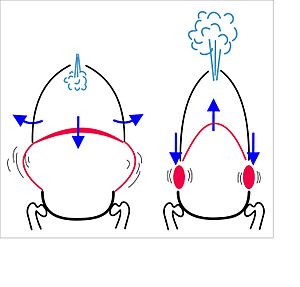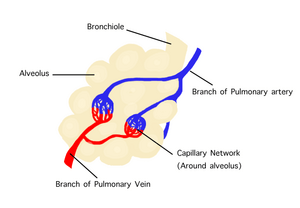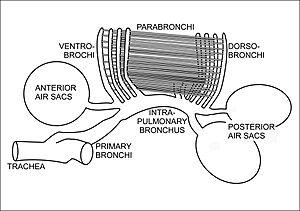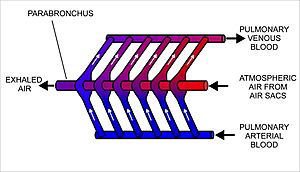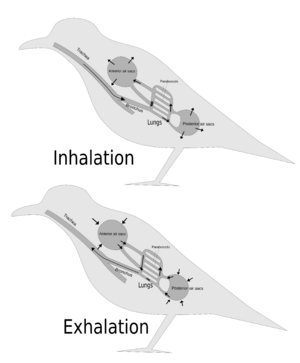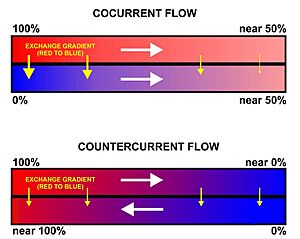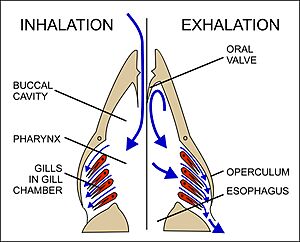Respiratory system facts for kids
Quick facts for kids Respiratory system |
|
|---|---|
 |
|
| A complete, schematic view of the human respiratory system with their parts and functions. | |
| Latin | systema respiratorium |
The respiratory system helps our bodies get the oxygen we need and get rid of waste carbon dioxide. Think of it like a special exchange system. We breathe in air that has lots of oxygen. Our bodies use this oxygen to create energy. As a result, our bodies produce carbon dioxide, which is a waste gas. We then breathe out this carbon dioxide.
This amazing process happens in a few steps. First, we breathe in air, which is called inhalation. Next, inside our lungs, oxygen moves into our blood, and carbon dioxide moves out of our blood. This is called gas exchange. Then, our body cells use the oxygen to make chemical energy and more carbon dioxide. Finally, we breathe out the carbon dioxide.
Animals have different ways of breathing. Fish use gills to breathe underwater. Insects have simple tubes. Amphibians can even breathe through their skin! Plants also have a respiratory system, but they take in carbon dioxide and release oxygen.
Contents
Breathing
To stay alive, our bodies need a constant supply of oxygen. We get this oxygen by breathing. Breathing in is called inhalation. When we inhale, our lungs get bigger. This makes the air pressure inside our lungs lower than the air pressure outside. Because of this, air from outside rushes into our lungs.
How do our lungs get bigger? A strong muscle called the diaphragm (which is below your lungs) and muscles between your ribs tighten up. This makes your chest expand, and your lungs expand too. Air first enters through your nose and mouth. Then it goes down your larynx (voice box) and into your trachea (windpipe). From there, it travels into your lungs.
Inside your lungs, the trachea splits into many smaller tubes, like branches of a tree. First, the air goes through larger branches called bronchi. Then it goes into even smaller branches called bronchioles. Finally, it reaches tiny air sacs. These air sacs are where oxygen and carbon dioxide are swapped.
After gas exchange, the air sacs are full of carbon dioxide. We need to breathe this out, which is called exhalation. To exhale, your diaphragm and rib muscles relax. This makes your lungs get smaller. As the lungs shrink, the air pressure inside them becomes higher than the air pressure outside. This forces the air out of your body. The air you breathe out has a lot of carbon dioxide and not much oxygen. The most air you can breathe in and out is called your vital capacity, which can be up to five liters.
Gas Exchange
When you inhale, the air travels all the way down to the tiny air sacs at the end of each bronchiole. These air sacs are called alveoli. They are perfect for gas exchange because they have a very large surface area, are moist, are very thin, and are close to many tiny blood vessels.
The air you breathe in has much more oxygen than carbon dioxide. On the other hand, the blood flowing to your lungs has more carbon dioxide than oxygen. This creates a "concentration gradient." It means there's a big difference in the amount of oxygen and carbon dioxide between the air in your air sacs and your blood.
Because the walls of the air sacs and blood vessels are so thin, gases can easily move across them. Oxygen, which is high in the air sacs, moves into your blood where oxygen is low. At the same time, carbon dioxide, which is high in your blood, moves into the air sacs where carbon dioxide is low. The oxygen-rich blood then travels through your circulatory system to be used by all the cells in your body. The carbon dioxide in the air sacs is then breathed out.
Amazing Mammals
Horses
Horses are special because they can only breathe through their noses. They cannot breathe through their mouths like many other mammals. A flap of tissue called the soft palate blocks off their throat from their mouth, except when they are swallowing. This helps stop them from breathing in food. But it also means if a horse has trouble breathing, it can only use its nostrils.
Elephants
Elephants are unique among mammals because their lungs are directly attached to their diaphragm. They don't have the usual space around their lungs that other mammals do. Their diaphragm is also unusually thick. Scientists believe these features help elephants stay underwater for a long time while breathing through their trunk, which acts like a snorkel! Their breathing mostly relies on their diaphragm, not on their ribcage expanding.
Birds
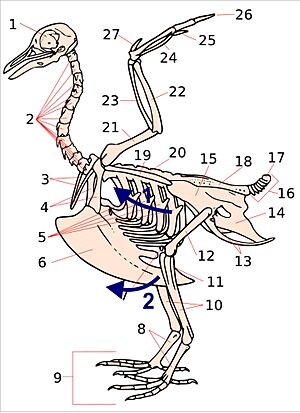
The way birds breathe is very different from mammals. Birds have lungs that are stiff and do not expand and shrink like ours do. Instead, they have a large system of air sacs throughout their bodies (Fig. 15). These air sacs act like bellows, pulling air into the sacs and pushing used air out after it has gone through the lungs. Birds also do not have a diaphragm or spaces around their lungs.
Bird lungs are smaller than mammal lungs of the same size. However, their air sacs make up about 15% of their total body volume. This is much more than the tiny air sacs (alveoli) in mammals, which only make up about 7%.
Birds breathe in and out by changing the size of their whole body cavity, using both their belly and rib muscles. When they breathe in, muscles attached to their ribs (Fig. 17) pull them forward and outward. This pushes the breastbone (sternum) down and forward (Fig. 17). This movement makes the chest area bigger. The sternum also pulls the belly wall down, making that part of the body bigger too. When the whole body cavity gets bigger, the air pressure inside all the air sacs drops, causing them to fill with air.
When birds breathe out, special muscles reverse these movements. They squeeze the belly area, which increases the pressure in all the air sacs. This forces the air out of the respiratory system.
When a bird breathes in, air enters through its nostrils and mouth, goes down the trachea, and then splits into two main tubes called primary bronchi (Fig. 16). These bronchi enter the lungs. Inside the lungs, the primary bronchi branch into other tubes called ventrobronchi and dorsobronchi (Fig. 16). The ends of the primary bronchi send air into the posterior (back) air sacs.
From the dorsobronchi, the inhaled air flows through many tiny air capillaries called parabronchi (Fig. 16). This is where gas exchange happens. As the bird inhales, fresh air fills the posterior air sacs and also flows through the parabronchi to the anterior (front) air sacs. So, during inhalation, both the back and front air sacs expand. The back air sacs fill with fresh air, while the front air sacs fill with "used" (oxygen-poor) air that has just passed through the lungs.
When a bird breathes out, the pressure in the posterior air sacs (which held fresh air) increases. The way the tubes are shaped makes sure this fresh air flows from the posterior air sacs into the lungs (through the dorsobronchi), rather than going back up the main tubes (Fig. 18). From the dorsobronchi, this fresh air flows through the parabronchi (in the same direction as during inhalation) into the ventrobronchi. The used, oxygen-poor air from the ventrobronchi and anterior air sacs then goes to the trachea and out of the bird's body. This means that oxygen-rich air flows constantly in one direction through the parabronchi during the entire breathing cycle.
The blood flows through the bird's lung at a right angle to the air flow through the parabronchi. This is called a cross-current exchange system (Fig. 19). This system is very efficient at getting oxygen into the blood. Even though birds have a long windpipe (trachea) which holds some "dead space" air (air that doesn't reach the lungs for gas exchange), their breathing system is highly effective. Some birds, like the whooper swan, have incredibly long tracheae that coil inside their bodies. We don't fully understand why they have this unique feature.
Reptiles
The lungs of reptiles are simpler than those of mammals. They don't have the complex branching airways that mammals do. However, gas exchange in reptiles still happens in tiny air sacs called alveoli. Reptiles do not have a diaphragm. Instead, they breathe by changing the size of their body cavity. This is controlled by muscles between their ribs. Turtles are different; they use special flank muscles to breathe in and out.
Amphibians
Amphibians use both their lungs and their skin to breathe. When they breathe with their lungs, they use a method called positive pressure ventilation. They lower the floor of their mouth, which makes it bigger and pulls air in through their nostrils. Then, with their nostrils and mouth closed, they push the floor of their mouth up. This forces the air down their trachea and into their lungs.
The skin of amphibians is very important for breathing. It's full of blood vessels and stays moist because of special mucus. This moist, thin skin allows for quick gas exchange, especially when amphibians are underwater in oxygen-rich water. Some amphibians, like tadpoles, have gills when they are young. Some salamanders even keep their gills into adulthood.
Fish
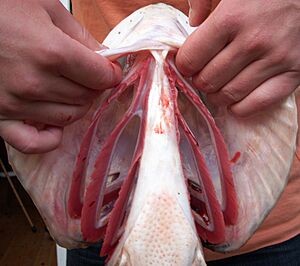
Oxygen doesn't dissolve very well in water. So, there's much less oxygen in water than in air. Also, oxygen moves much slower through water than through air. Fish have developed amazing gills to deal with these challenges. Gills are special organs with many thin parts called filaments, which are further divided into tiny plates called lamellae. These lamellae have a dense network of tiny blood vessels, creating a huge surface area for gas exchange with the large amounts of water flowing over them.
Fish gills use a clever system called countercurrent exchange. This makes them very efficient at taking oxygen from the water. Fresh, oxygen-rich water is constantly "pumped" through the gills in one direction. At the same time, the blood in the lamellae flows in the opposite direction (Fig. 22). This countercurrent flow of blood and water is vital for the fish to survive.
Water is pulled into the fish's mouth when it closes its operculum (gill cover) and makes its mouth cavity bigger (Fig. 23). At the same time, the gill chambers get bigger, creating lower pressure there. This causes water to flow over the gills. Then, the mouth cavity shrinks, forcing the water over the gills and out through the opercular openings (Fig. 23). This pumping action keeps a steady flow of water over the gills in one direction. Because the blood flows in the opposite direction to the water, the countercurrent system keeps a strong difference in oxygen and carbon dioxide levels along the entire length of each blood vessel (Fig. 22). This allows oxygen to keep moving into the blood and carbon dioxide to keep moving into the water.
Some fast-swimming sharks, like those in the open ocean, breathe by simply swimming with their mouths open. This forces water over their gills, a process called "ram ventilation." Most sharks, however, pump water over their gills when they are resting, just like most bony fish. A few species of sharks cannot pump water and must swim constantly to breathe. If they stop, they would suffocate.
Some fish can breathe air for short periods. lungfish have one or two lungs. Labyrinth fish have a special "labyrinth organ" that helps them take oxygen directly from the air. This organ allows them to survive out of water for a short time, as long as they stay moist. Young labyrinth fish breathe with gills and develop their labyrinth organs as they grow older.
Invertebrates
Arthropods
Some crabs have a special breathing organ called a branchiostegal lung. It's like a gill but better at taking oxygen from the air. The smallest spiders and mites can breathe simply through their skin. Larger spiders, scorpions, and other arthropods use a simple "book lung."
Insects
Most insects breathe through small holes in their hard outer shell called spiracles. Air travels from these holes through a network of tubes called tracheae and then into even smaller tubes called tracheoles. These tiny tracheoles reach every cell in the insect's body. They are partly filled with fluid. When muscles are active and need a lot of oxygen, this fluid can be pulled away, bringing the air closer to the cells. This is why insects are usually small; gases don't diffuse well over long distances. Some insects without spiracles breathe directly through their skin.
Insects have different numbers of spiracles, but they always come in pairs, one on each side of the body. Some insects, like dragonflies and grasshoppers, have two pairs on their chest and eight pairs on their belly. It was once thought that insects just passively exchanged gases. However, we now know that many insects can control their spiracles and use muscle contractions in their belly to help them breathe. This helps them get enough oxygen and also reduces water loss.
Molluscs
Molluscs usually have gills that allow them to exchange gases between the water and their blood. They also have a heart that pumps blood containing a special molecule called hemocyanin to carry oxygen. So, their respiratory system is similar to that of fish. Some snails (gastropods) have either gills or a lung.
Plants
Plants use carbon dioxide gas for a process called photosynthesis. During photosynthesis, they release oxygen gas as a waste product. The chemical reaction for photosynthesis is: carbon dioxide + water + sunlight = glucose (sugar) + oxygen. Plants use the energy from sunlight to make food.
Respiration in plants is the opposite of photosynthesis. It's how plants get energy from the food they made. In this process, carbon atoms combine with oxygen to form carbon dioxide, which is then released. Plants do both: photosynthesis to capture energy and respiration to use it.
Plants take in carbon dioxide through tiny holes called stomata, which are usually on the underside of their leaves. These holes can open and close. Most plants need some oxygen for their energy-releasing processes, but they don't use much. However, they need a lot of carbon dioxide for photosynthesis, and carbon dioxide makes up only a tiny part of the air (about 0.04%). So, plants need to process a lot of air to get enough carbon dioxide.
Related pages
Images for kids
-
Fig. 13 An aerial photo of Mount Everest.
See also
 In Spanish: Aparato respiratorio para niños
In Spanish: Aparato respiratorio para niños


